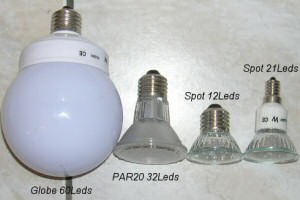LED bulbs made of 220 / 240V have recently appeared on the market.

So many people have bought and continue to buy these bulbs; out of curiosity but above all by thinking of saving electricity and / or helping the environment.
However…the consumptions announced by the sellers and by the packaging have nothing to do (in the "wrong way" obviously) with the actual consumptions !!!
1) Consumer testing.
Indeed; during a routine verification test on 220V LED bulbs, we were able to highlight over-consumption ranging from 160 to 460% compared to advertising indications !
2) Tests in luminous efficiency.
This observed overconsumption, we decided to carry out more complete tests of luminous efficiency.
That is to say that for each LED bulb, in addition to measuring the power (thanks to a PM230, click here), we made 4 measurements of brightness in Lux. The average of these luminosity measurements compared to the electrical power consumed gave us an average luminous efficiency.
The results are catastrophic for LED lamps since a classic incandescent bulb does better ...
See the precise measurement protocol and our readings
3) Preliminary conclusion.
These results were confirmed by other measurements carried out independently of ours, and on LED bulbs of different brands.
We can, without great risk of error, to conclude to false advertising but beware, this only concerns 220V LED bulbs and brands we have tested.
These results do not therefore call into question the technology of white LEDs, which is very efficient at low voltage. But they reveal a "fairly serious" problem concerning the technology but especially the marketing of 220 / 240V LED bulbs ...
Stay tuned!
Following the 5 September 2007.
These remarks do not apply to certain 220V LED bulbs of higher quality, nor to 12V LED bulbs in MR16-GU5.3

